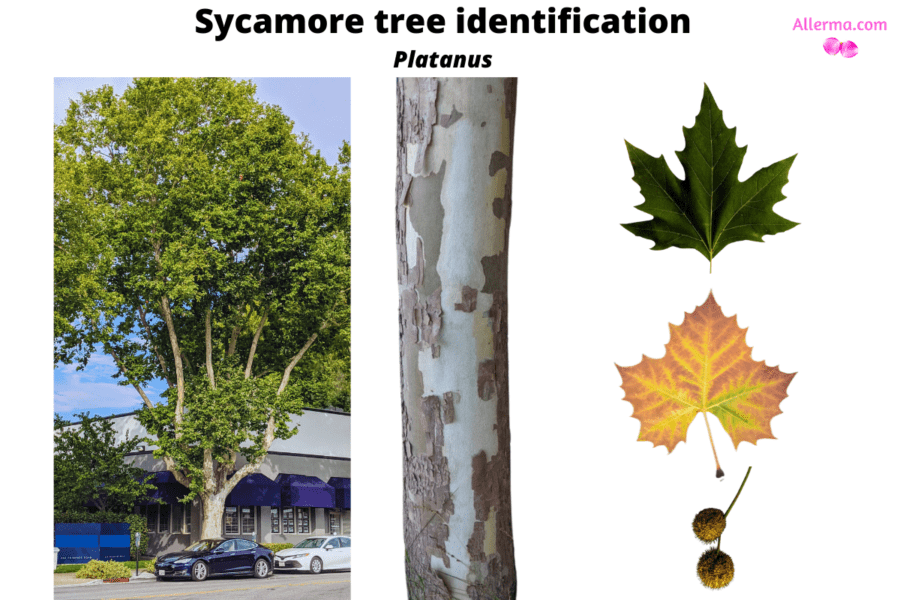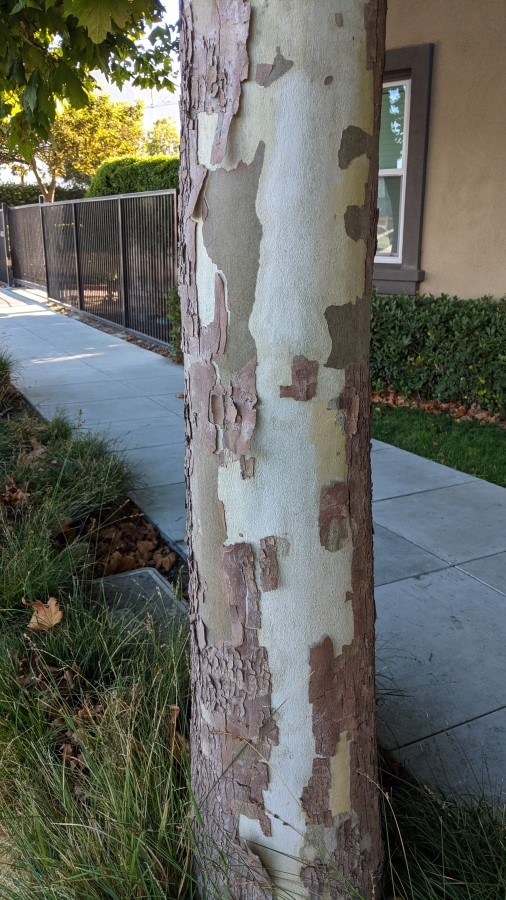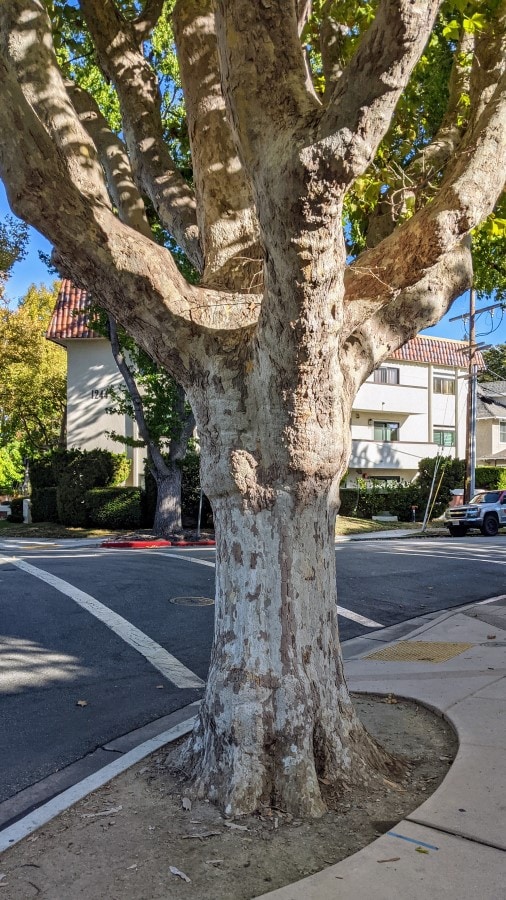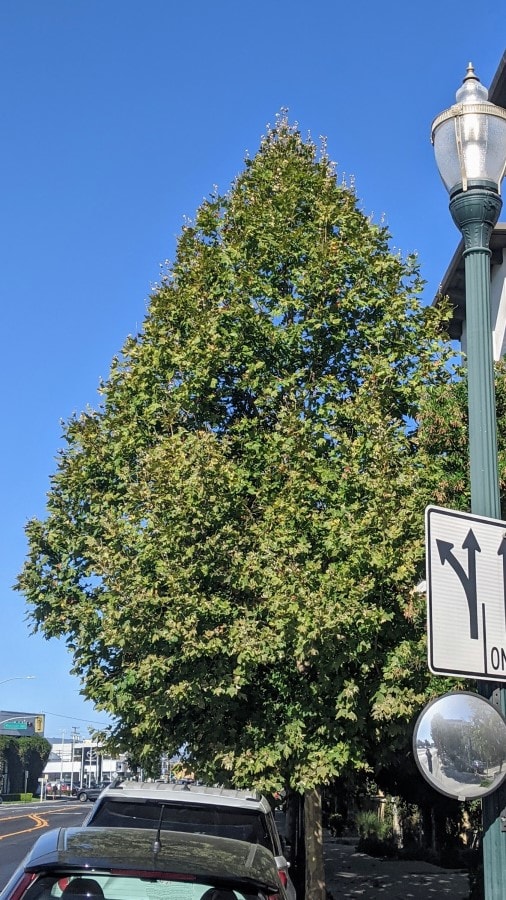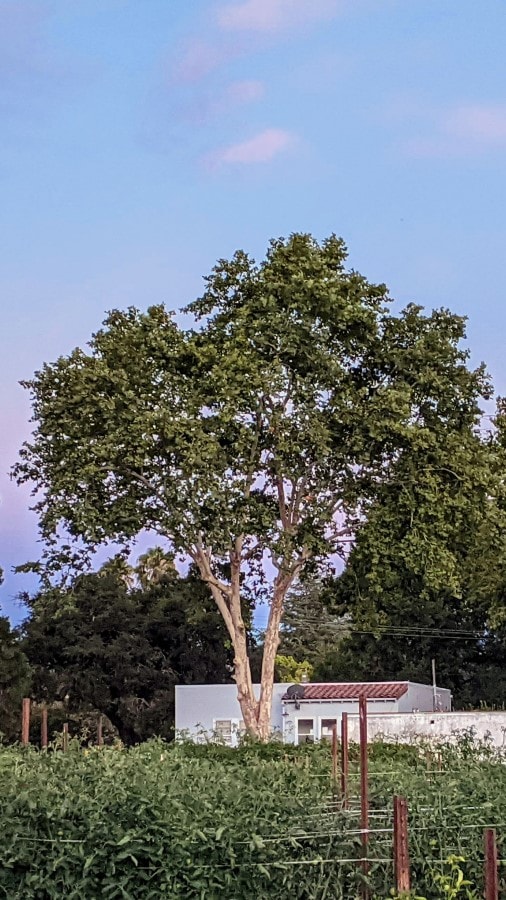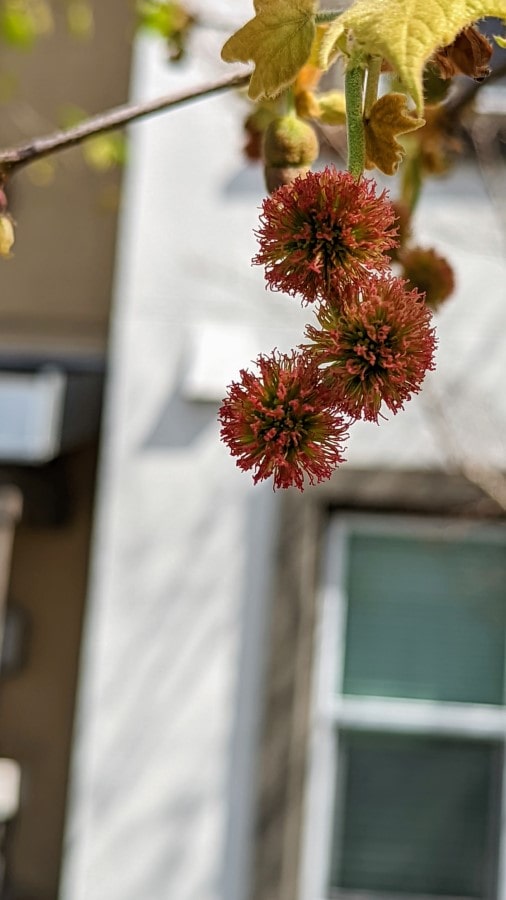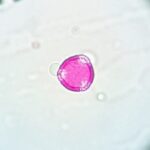In this article, we will learn to identify Sycamore or Planetrees (scientific name: Platanus) as well as how and when their pollen spreads.
| Sycamore or Planetree (Genus: Platanus) | Pollen allergy profile |
|---|---|
| Pollen season | Spring |
| Pollination type | Primarily wind-transported. Each tree produces a large amount of pollen. |
| Cross-reactivity with other pollen | Only the trees within the genus Platanus e.g. London Planetree, American Sycamore, Western Sycamore, etc. |
| Pollen source | Male flowers on the tree that look like small greenish-yellow berries. |
| Gender | Monoecious: Each tree has both male and female flowers. |
| Bark | The brownish-grey peeling and flaky bark show creamy white under surface (see pictures below) |
| Leaves | Star-shaped with generally five lobs and coarse toothy edges |
| Fruit | Green furry balls, slightly bigger than a golf ball, that turn yellow and brown upon maturation. |
How to identify a Sycamore tree or Planetree(Platanus)?
The three primary characteristics of a sycamore tree are:
- It’s creamy-white bark with light brown scales that for some species become knobby as the tree ages.
- A star-shaped leaf, generally, with five lobs and coarse toothy edges, which looks a lot like a maple leaf.
- Golf-sized, furry, yellow-brown fruit that hangs from long thin stalks.
The leaves are green during spring and summer but turn yellow during autumn before falling off. The leaves also show white fungus towards the autumn. The fruit stays on the tree through winter, but some trees may not be mature enough to have fruit.
Platanus tree can be easily identified by its scaly peeling brown bark with a grey and white undercoat, a star-shaped leaf with five lobes, and golf-ball-sized yellow-brown fruit.
Bark and trunk
The tree bark is creamy-white with light-brown scales. The young tree’s trunk is straight but the older tree trunks become a bit knobby and branch out at around 6 to 8 feet. The trunk can have a diameter of 1 to 4 feet at the human eye level.
Trees
Sycamore trees can grow up to 75 feet tall but are trimmed to lower heights in the cities. The trunk is 1 to 4 feet in diameter at the human eye level. The canopy could be pyramidal, round, or vase-shaped.
Flowers
The male and female flowers appear in spring. The female flowers are small furry purple spheres hanging in groups of two or three. The male flowers, on the other hand, are greenish-yellow.
Both male and female flowers are the size of a large peanut when young. The female flower matures into the larger golf-sized fruit after fertilization.
How to know if Sycamore trees are releasing pollen?
The tree generally produces pollen before leaves start to emerge in the spring. The tree often looks bare, but by the time the four week long pollen cycle completes, the tree is quite lush with leaves.
During which months do Sycamore trees release pollen?
Sycamore tree allergies are spring phenomena. In Northern California, the Sycamores release pollen between March-15th and April-15th. On the East coast of the US, where the spring arrives a little later, the pollen could be expected from April-15th to May-15th.
The tree releases pollen for three to four weeks during spring. Depending on the weather, the pollination window can shift each week. If you suffer from sycamore allergies, it is best to learn about the tree and its pollen-producing habits.
However, if you live in the San Francisco Bay Area, you have an easier way out! I do regular tree inspections and air sampling in the area to provide reliable pollen updates on our website
How does Sycamore pollen spread?
The sycamore tree releases its pollen in the air and wind can carry the pollen many miles. Inhaling the pollen is what causes the allergies.
Since the tree is widely planted on the West Coast as well as the East Coast, it is fair to expect its pollen to be airborne during spring in the entire United States.
Sycamore trees have a short pollination cycle that rarely goes past four weeks.
What does sycamore pollen look like?
On a slightly windy day during spring, one can see sycamore pollen as yellow dust coming off the tree. However, each individual grain is invisible to the naked eye.
The Sycamore pollen grain is around 20 micrometers (0.02 mm) with three short furrows. The furrows have warty structures. Platanus pollen: Small, 20 microns, three short furrows with verruci.
To see the pollen of other plants and trees, visit our pollen library.
Sycamore allergy summary
Sycamore/Planetree (Genus: Platanus) releases pollen during spring but does so for a short period of three to four weeks. Sycamore tree allergies are not as common as are allergies from the other spring bloomers such as Ash, birch, oak, cypress, and junipers.
Sources
References
- Allergy Plants by Mary Jelks, M.D.
- Plant identification terminology by James G. Harris and Melinda Woolf Harris (Second Edition)
- Sampling and indentifying pollens and Molds by E. Grant Smith
All pictures, unless otherwise credited to another source, are taken by the author and are copyrighted material. The pollen picture is taken in our aerobiology lab using an Olympus compound microscope.


